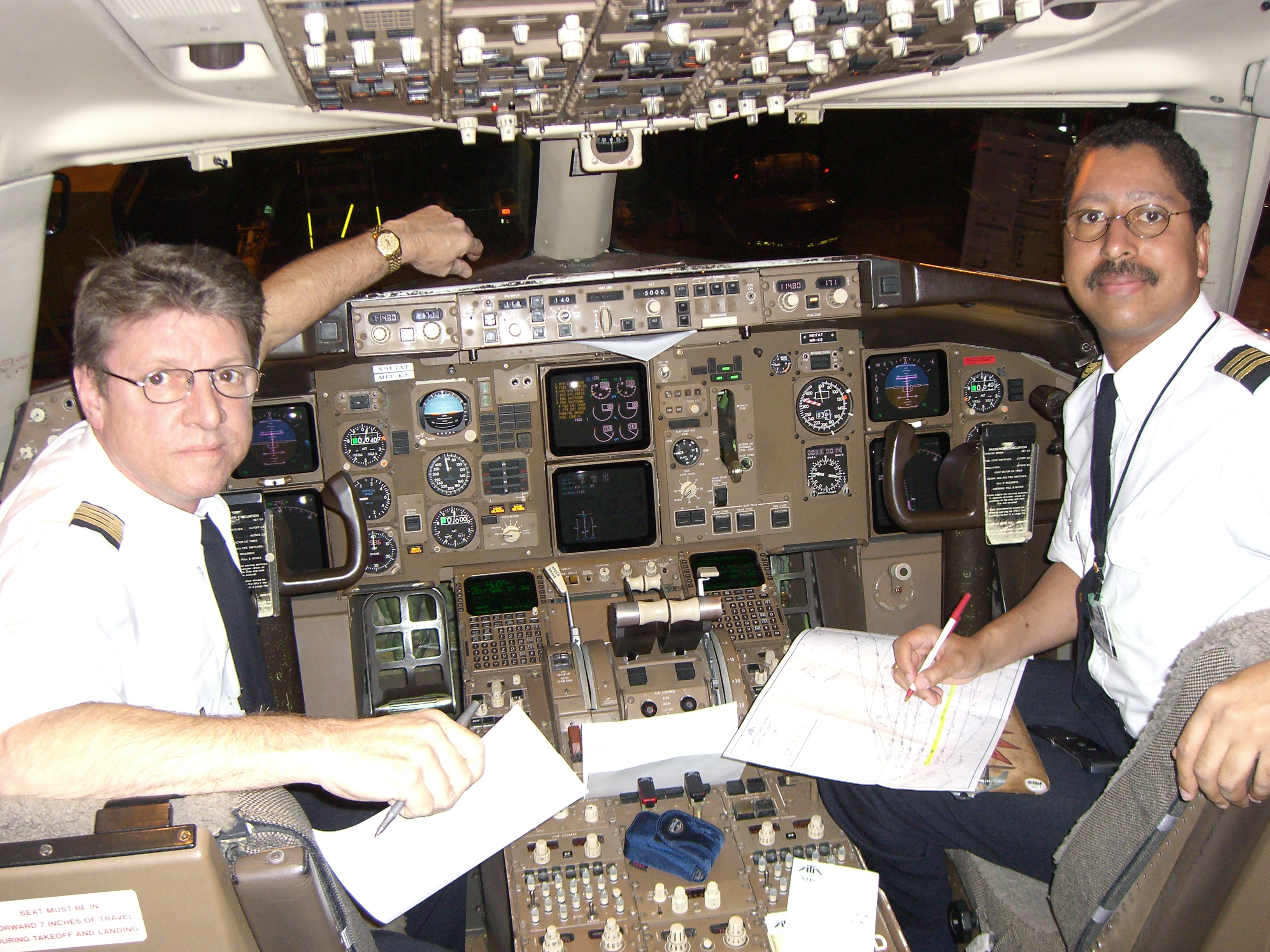|
Third Officer (aviation)
Third officer is a lesser used civil aviation rank. It was primarily used by Pan Am, particularly on its Clippers flying boats during the infancy of extended range airline routes. The third officer would serve as a relief pilot and aircrew member, and could move between pilot, co-pilot, radio officer, and flight engineer positions to provide a rest period for the primary crews. Third officers in modern civil aviation are often not formally titled as such. Rather, these relief pilots take on a junior first officer rank or in some cases a second officer rank. Notable third officers * Gene Roddenberry (Pan Am) See also * Pilot in command The pilot in command (PIC) of an aircraft is the person aboard the aircraft who is ultimately responsible for its operation and safety during flight. This would be the captain in a typical two- or three- pilot aircrew, or "pilot" if there is on ... * Second Officer * Third mate References Citations Bibliography * Harris ... [...More Info...] [...Related Items...] OR: [Wikipedia] [Google] [Baidu] |
Civil Aviation
Civil aviation is one of two major categories of flying, representing all non-military and non-state aviation, both private and commercial. Most of the countries in the world are members of the International Civil Aviation Organization and work together to establish common Standards and Recommended Practices for civil aviation through that agency. Civil aviation includes three major categories: * Commercial air transport, including scheduled and non-scheduled passenger and cargo flights * Aerial work, in which an aircraft is used for specialized services such as agriculture, photography, surveying, search and rescue, etc. * General aviation (GA), including all other civil flights, private or commercial Although scheduled air transport is the larger operation in terms of passenger numbers, GA is larger in the number of flights (and flight hours, in the U.S.) In the U.S., GA carries 166 million passengers each year, more than any individual airline, though less than all the airl ... [...More Info...] [...Related Items...] OR: [Wikipedia] [Google] [Baidu] |
Pan Am
Pan American World Airways, originally founded as Pan American Airways and commonly known as Pan Am, was an American airline that was the principal and largest international air carrier and unofficial overseas flag carrier of the United States for much of the 20th century. It was the first airline to fly worldwide and pioneered numerous innovations of the modern airline industry such as jumbo jets, and computerized reservation systems. Until its dissolution in 1991, Pan Am "epitomized the luxury and glamour of intercontinental travel", and it remains a cultural icon of the 20th century, identified by its blue globe logo ("The Blue Meatball"), the use of the word " Clipper" in its aircraft names and call signs, and the white uniform caps of its pilots. Founded in 1927 by two former U.S. Army Air Corps majors, Pan Am began as a scheduled airmail and passenger service flying between Key West, Florida, and Havana, Cuba. Under the leadership of American entrepreneur Juan Trippe, ... [...More Info...] [...Related Items...] OR: [Wikipedia] [Google] [Baidu] |
Boeing 314 Clipper
The Boeing 314 Clipper was an American long-range flying boat produced by Boeing from 1938 to 1941. One of the largest aircraft of its time, it had the range to cross the Atlantic and Pacific oceans. For its wing, Boeing re-used the design from the earlier XB-15 bomber prototype. Twelve Clippers were built, nine of which served with Pan Am. Design and development Pan American had requested a truly trans-Pacific flying boat with unprecedented range and double the passenger payload of the airline's Martin M-130. Boeing's bid was successful and on July 21, 1936, Pan American signed a contract for six. Boeing engineers adapted the cancelled XB-15's wing, and replaced the Pratt & Whitney Twin Wasp radial engines with the Wright Twin Cyclone. Pan Am ordered six more aircraft with increased engine power and capacity for 77 daytime passengers as the Boeing 314A. The huge flying boat was assembled at Boeing's Plant 1 on the Duwamish River in Seattle, and towed to Elliott Bay fo ... [...More Info...] [...Related Items...] OR: [Wikipedia] [Google] [Baidu] |
In-flight Crew Relief
In-flight crew relief (commonly referred in noun form as the relief aircrew, relief flight crew, or just relief crew), is a term used in commercial aviation when referring to the members of an aircrew intended to temporarily relieve active crew members of their duties during the course of a flight. The term and its role are almost exclusively applied to the secondary pilots of an aircrew, commonly referred to as relief pilots, that relieve the primary and active captain and/or first officer (co-pilot) in command of an aircraft to provide prolonged breaks for rest or sleep opportunities. Usage In-flight crew relief is generally required for flights that are determined to be long haul or "ultra-long haul" on aircraft commercially operated (airline operated). In certain places such as the United States, flights will be given these classifications and equipped with relief crews when around or exceeding 8–12 hours domestically or internationally. Operators of these flights prototyp ... [...More Info...] [...Related Items...] OR: [Wikipedia] [Google] [Baidu] |
Aircrew
Aircrew, also called flight crew, are personnel who operate an aircraft while in flight. The composition of a flight's crew depends on the type of aircraft, plus the flight's duration and purpose. Commercial aviation Flight deck positions In commercial aviation, the aircrew are called ''flight crew''. Some flight crew position names are derived from nautical terms and indicate a rank or command structure similar to that on ocean-going vessels, allowing for quick executive decision making during normal operations or emergency situations. Historical flightdeck positions include: * Captain, the pilot highest-ranking member or members of a flight crew. * First officer (FO, also called a co-pilot), another pilot who is normally seated to the right of the captain. (On helicopters, an FO is normally seated to the left of the captain, who occupies the right-hand seat).Smith, PatrickPatrick Smith's Ask The Pilot: When a Pilot Dies in Flight AskThePilot.com website, 2013, whic ... [...More Info...] [...Related Items...] OR: [Wikipedia] [Google] [Baidu] |
First Officer (aviation)
In aviation, the first officer (FO), also called co-pilot, is the pilot who is second-in-command of the aircraft to the captain, who is the legal commander. In the event of incapacitation of the captain, the first officer will assume command of the aircraft. Control of the aircraft is normally shared equally between the first officer and the captain, with one pilot normally designated the " pilot flying" and the other the "pilot not flying", or "pilot monitoring", for each flight. Even when the first officer is the flying pilot, however, the captain remains ultimately responsible for the aircraft, its passengers, and the crew. In typical day-to-day operations, the essential job tasks remain fairly equal. Traditionally, the first officer sits on the right-hand side of a fixed-wing aircraft (" right seat") and the left-hand side of a helicopter (the reason for this difference is related to, in many cases, the pilot flying being unable to release the right hand from the cyclic co ... [...More Info...] [...Related Items...] OR: [Wikipedia] [Google] [Baidu] |
Flight Engineer
A flight engineer (FE), also sometimes called an air engineer, is the member of an aircraft's flight crew who monitors and operates its complex aircraft systems. In the early era of aviation, the position was sometimes referred to as the "air mechanic". Flight engineers can still be found on some larger fixed-wing airplanes and helicopters. A similar crew position exists on some spacecraft. In most modern aircraft, their complex systems are both monitored and adjusted by electronic microprocessors and computers, resulting in the elimination of the flight engineer's position. In earlier days, most larger aircraft were designed and built with a flight engineer's position. For U.S. civilian aircraft that require a flight engineer as part of the crew, the FE must possess an FAA Flight Engineer Certificate with reciprocating, turboprop, or turbojet ratings appropriate to the aircraft. Whereas the four-engine Douglas DC-4 did not require an FE, the FAA type certificates of subsequent ... [...More Info...] [...Related Items...] OR: [Wikipedia] [Google] [Baidu] |
Second Officer (aviation)
In aviation, a second officer is usually the third in line of command for a flight crew on a civil aircraft. In the past years of commercial aviation, a second officer would be used on international or long haul flights where more than two crew are required for the purpose of relieving other higher ranked crew members for adequate resting periods. In some airlines, the second officer acts as a first officer, but still undergoes training and supervision from a training captain (Swiss International Air Lines, Lufthansa, Volotea among others use this denomination). Some major airlines in China also use this denomination including Air China and China Eastern Airlines. See also * Pilot in command The pilot in command (PIC) of an aircraft is the person aboard the aircraft who is ultimately responsible for its operation and safety during flight. This would be the captain in a typical two- or three- pilot aircrew, or "pilot" if there is on ... * Second mate References * Har ... [...More Info...] [...Related Items...] OR: [Wikipedia] [Google] [Baidu] |
Gene Roddenberry
Eugene Wesley Roddenberry Sr. (August 19, 1921 – October 24, 1991) was an American television screenwriter, producer, and creator of '' Star Trek: The Original Series'', its sequel spin-off series '' Star Trek: The Animated Series,'' and '' Star Trek: The Next Generation''. Born in El Paso, Texas, Roddenberry grew up in Los Angeles, where his father was a police officer. Roddenberry flew 89 combat missions in the Army Air Forces during World War II and worked as a commercial pilot after the war. Later, he followed in his father's footsteps and joined the Los Angeles Police Department, where he also began to write scripts for television. As a freelance writer, Roddenberry wrote scripts for '' Highway Patrol'', '' Have Gun – Will Travel'', and other series, before creating and producing his own television series, '' The Lieutenant.'' In 1964, Roddenberry created '' Star Trek'', which premiered in 1966 and ran for three seasons before being canceled. He then worked on o ... [...More Info...] [...Related Items...] OR: [Wikipedia] [Google] [Baidu] |
Pilot In Command
The pilot in command (PIC) of an aircraft is the person aboard the aircraft who is ultimately responsible for its operation and safety during flight. This would be the captain in a typical two- or three- pilot aircrew, or "pilot" if there is only one certificated and qualified pilot at the controls of an aircraft. The PIC must be legally certificated (or otherwise authorized) to operate the aircraft for the specific flight and flight conditions, but need not be actually manipulating the controls at any given moment. The PIC is the person legally in charge of the aircraft and its flight safety and operation, and would normally be the primary person liable for an infraction of any flight rule. The strict legal definition of PIC may vary slightly from country to country. The International Civil Aviation Organization, a United Nations agency, definition is: "The pilot responsible for the operation and safety of the aircraft during flight time." ''Flight time'' for airplanes is defin ... [...More Info...] [...Related Items...] OR: [Wikipedia] [Google] [Baidu] |



.jpg)


